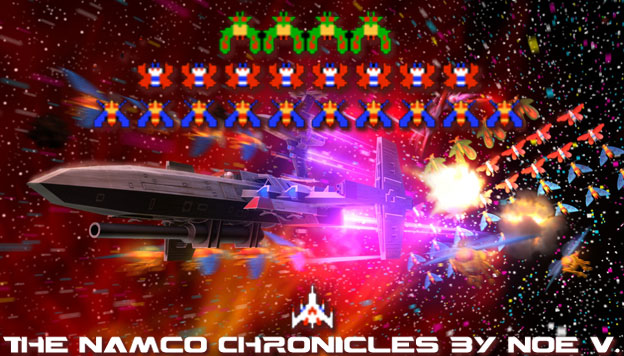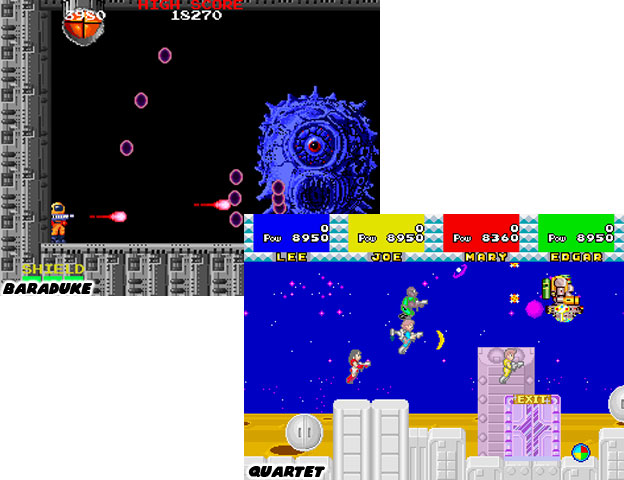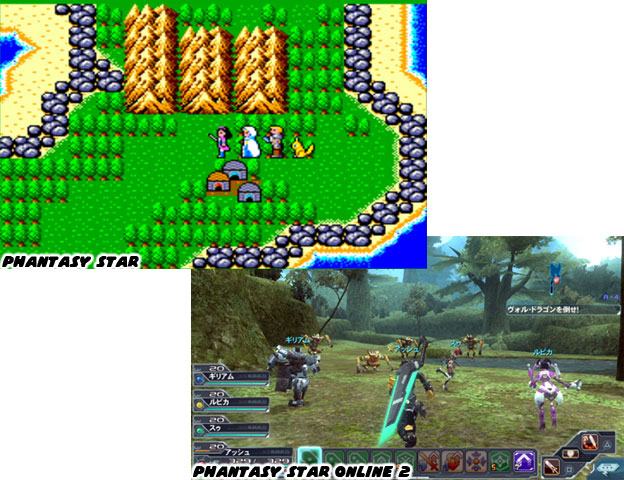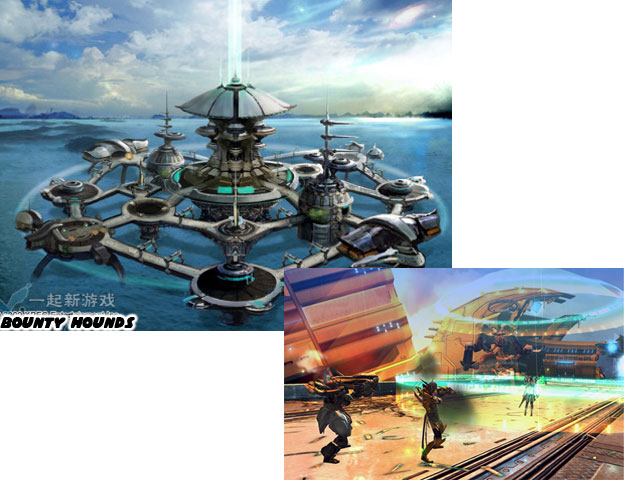
Much earlier in this series I mentioned that Sega and Namco had been trading punches through most of their tenure in the arcade. Like an ongoing rap battle between two heavyweights (that didn’t end in gunfire) there was no definitive victor. Of course the fans would be happy to see the action as the years went on. Sega would be credited for better racing games but Namco would counter with longevity. In the space shooter arena Galaga had stomped the best work from Sega. That was of course until Sega reconsidered their approach. The studio released Space Harrier in 1985. The game had a similar graphics approach to Buck Rogers: The Planet of Zoom but instead of piloting a ship the player was controlling a futuristic soldier and his rocket powered gun. The character could run along the ground or fly into the air while shooting down alien life forms. It was a bold new idea for the genre and completely shook up audiences. Space Invaders and Asteroids had taught them that there was only one way to go alien hunting. All of a sudden players could become a super soldier and take on gigantic monsters single handedly.

Namco countered with Burning Force in 1989. The title had the same basic gameplay as Space Harrier, except in the Namco version players could get “power-ups” to increase their firepower. Players also rode atop a rocket bike that would be transformed in latter levels into a mini spaceship. The game wasn’t as well received in the US as it had been abroad but Namco was still demonstrating that they could match Sega beat-for-beat. When it came to space adventures Namco seemed to hold a slight advantage.
Both studios realized that gaming could be limited only by the imagination of the designers. They began experimenting with genres and to make things more interesting began taking audiences to alien worlds. Of course for the sake of action they had to be extremely hostile planets. This was the case in the 1986 game Quartet by Sega. It was a rare 4-player title that could be played on a single free standing cabinet. In it audiences had to fight their way from the surface of an alien planet into the core of a base. The opponents in the game were highly-evolved robots of different shapes and sizes. The players were equipped with high tech weapons and rocket backpacks to move through the stages.

Namco had released a game called Baraduke in 1986. It was better known as Alien Sector in the US and closely mirrored Sega’s game. Of course this was all coincidence because development on both titles took place at about the same time. In the single-player game audiences took on the role of a space soldier named Masuyo "Kissy" Toby. She had to infiltrate an alien complex and destroy the monsters trying to invade a nearby planet. Instead of robots she had to fight biological creatures that look like mutated bats and slugs. She also had use of a rocket backpack and advanced weaponry. While neither title became enormous blockbusters they still developed a following, the Namco game more so than the Sega title.
Gamers in Japan and the US became enamored with alien planets being the backdrop to different genres. From adventure to racing, action and even role playing games there was something unique about having humans and aliens interact in a title. Sega developed a unique game set on an alien world but that had the look and feel of classic RPG. It was a mix of fantasy and science fiction that went over well with audiences. Phantasy Star debuted for the Sega Master system in 1987. I remember very vividly playing through the title at my friend’s house. My family had an NES and his had the Master System. We would split our time playing the best of both consoles. In the early versions of Phantasy Star there was a lot more swords and sorcery but as the series continued it began to have a science fiction tilt to it. Aliens replaced monsters in dungeons and laser weapons replaced swords and arrows.

Sega would expand the scope of Phantasy Star over the years and refine the look of the character classes and their abilities. Like many genres there were some growing pains. First Sega had to wean audiences off of sprite based graphics and get them to accept the polygon models. Then they added action RPG elements to make it more appealing to mainstream gamers than the old turn-based combat system. The canon of the game was explored throughout the series adding all sorts of character classes and monsters in the process. It turned out that what looked like magic in earlier games was simply technology that had advanced to the point of being controlled by conscious thought. The publisher would keep the franchise going in one format or another for over two decades. They had most recently debuted Phantasy Star Online 2 for the PC in 2013. It looked stunning compared to the version I remember as a kid.
Namco had also spent several years exploring different space adventures. In 2006 the studio released a space quest called Bounty Hounds for the PSP. The portable game was very much in the vein of Phantasy Star Online, except it emphasized the combat portions even more. It was like a science fiction version of the popular Capcom fantasy game Monster Hunter. The characters visiting the various alien planets were more like mercenaries or bounty hunters instead of soldiers. This lent them a bit more leeway for the carnage audiences could inflict onto their opponents.

In 2012 and 2013 Namco looked at turning the game into an MMO. The Taiwanese developers XPEC created both the portable and PC games. They had experience with the MMO format, and more important, with Chinese trends which was important because China and Korea were booming economies that loved MMO experiences. Over the generations audiences enjoyed the idea of leaving the Earth behind and starring in an adventure on the furthest reaches of the galaxy. John Carter, Buck Rogers and Flash Gordon were early pulp heroes that set the foundation for the Star Trek and Star Wars universes. Science fiction film and television helped inspire a generation of game designers. A string of science fiction shooters from the west, including Halo, Gears of War and Mass Effect have only emphasized that understanding. Namco and Sega had pioneered the earliest off-planet adventures. They constantly provided inspiration for the young gamers and future designers, developers, artists and animators that had grown up in the ‘80s and ‘90s. Taking the battle to the homeworld of an alien planet was fun however there was a certain level of cool associated with piloting a spaceship. There was a transitional period between spite based and polygon based engines for the space shooter just as there had been for the racing genre. Would you care to guess who was leading the charge? We’ll look at a few games that set the bar in the next blog.
If you would like to sponsor me
please visit my Patreon page and consider donating each month, even as little as $1 would help make better blogs and even podcasts!





No comments:
Post a Comment